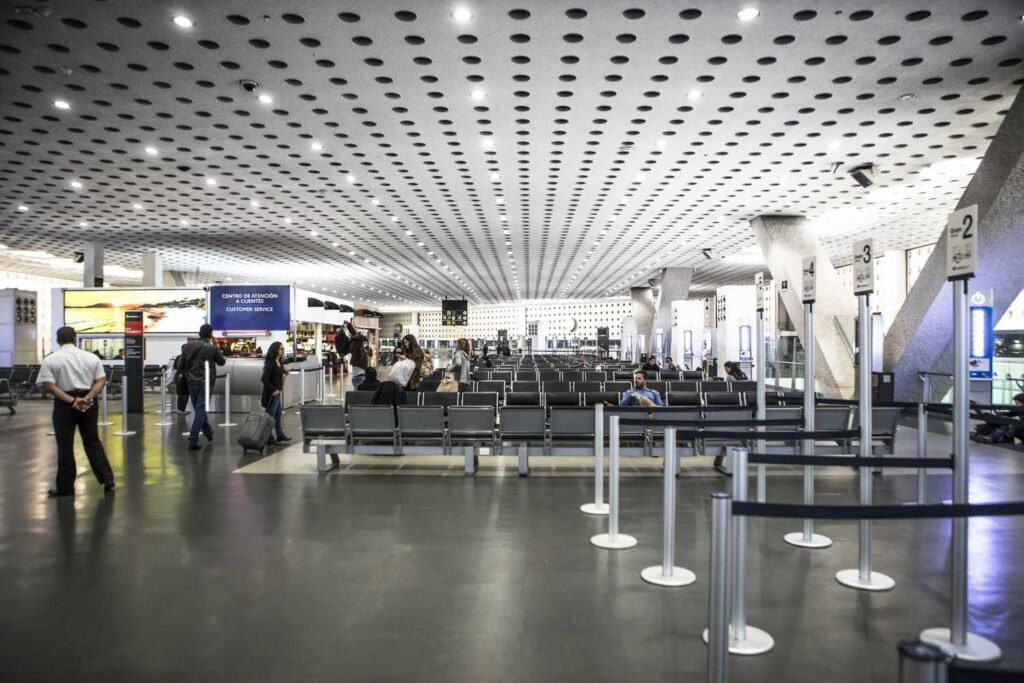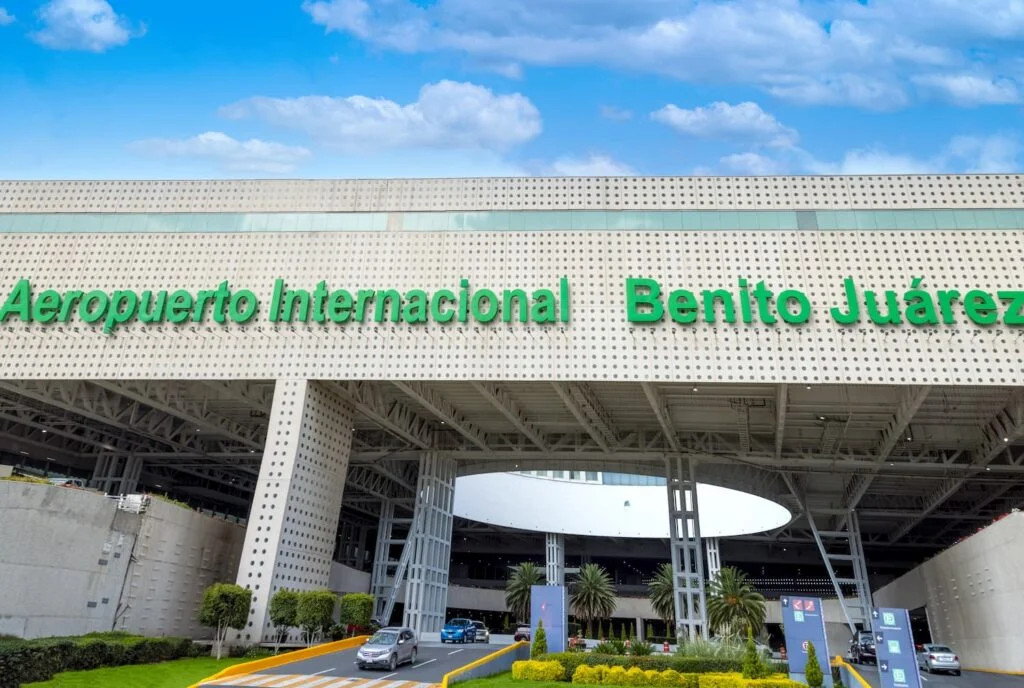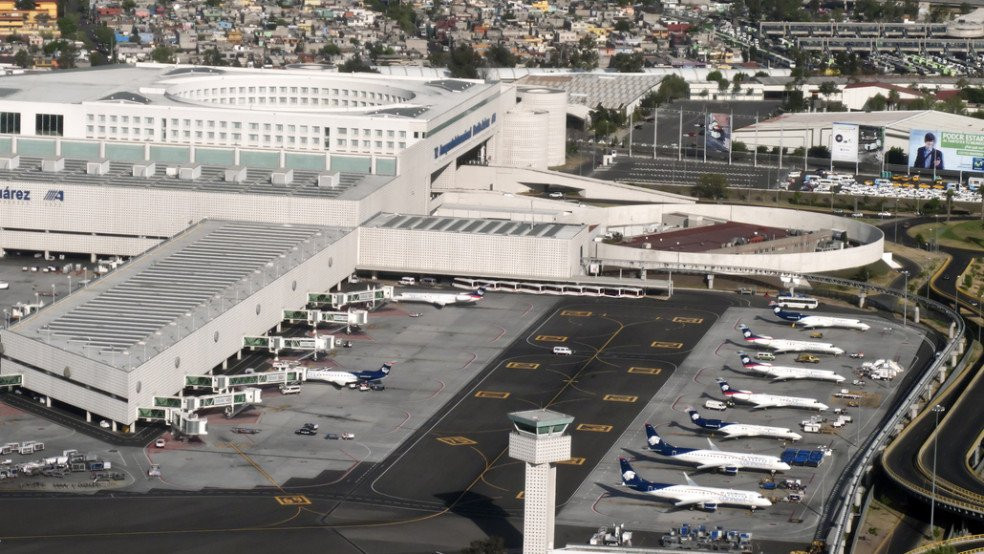Mexico City, a vibrant hub for culture and commerce, welcomes travelers from across the globe. If you’re planning a trip, a common question arises: How Many Airports Are In Mexico City? Gaymexico.net is here to clear up any confusion. The answer is that Mexico City is served by two main airports, each playing a crucial role in connecting the capital with the world. To make sure you’re fully prepared for your arrival or departure, we’ll explore both of these airports and provide tips for a smooth travel experience. Understanding the airport landscape can significantly enhance your travel plans, whether you’re visiting for leisure, business, or exploring the LGBTQ+ scene.
1. Understanding Mexico City’s Airports: A Detailed Overview
Mexico City is a major international gateway, and understanding its airport system is key to a smooth trip. So, to reiterate, how many airports are in Mexico City? There are two primary airports serving the metropolitan area: Benito Juárez International Airport (MEX) and Felipe Ángeles International Airport (NLU). Each airport has its own distinct characteristics, serving different needs and passenger demographics. This guide will give you a complete overview of both facilities.
1.1. Benito Juárez International Airport (MEX): The Main Hub
Benito Juárez International Airport (MEX), officially known as Aeropuerto Internacional Benito Juárez, is Mexico City’s primary and busiest airport. Located just east of downtown, it handles a large majority of international and domestic flights. MEX has two terminals:
- Terminal 1: Primarily serves domestic and international airlines (excluding those operating from Terminal 2). It offers a wide range of services, including shopping, dining, and transportation options.
- Terminal 2: Mainly used by Aeroméxico and its SkyTeam partners. It also offers various amenities, including lounges, restaurants, and shops.
MEX is a major hub for airlines such as Aeroméxico and Volaris. It connects Mexico City to destinations all over the world. Due to its central location and high traffic, it is essential to plan your arrival and departure carefully.
1.2. Felipe Ángeles International Airport (NLU): The Newcomer
Felipe Ángeles International Airport (NLU), also known as Aeropuerto Internacional Felipe Ángeles, is a newer airport located in Zumpango, approximately 45 kilometers (28 miles) north of Mexico City. Built to relieve congestion at MEX, NLU began operations in March 2022. It handles a growing number of domestic and international flights, focusing on low-cost carriers and regional routes.
- Terminal: NLU currently operates with a single terminal, offering a modern and efficient travel experience. It includes essential amenities such as dining, shopping, and transportation services.
NLU is becoming increasingly important for travelers seeking budget-friendly options. While it is farther from the city center, improved transportation links are continuously being developed to enhance accessibility. According to research from the Secretaría de la Defensa Nacional (SEDENA) in December 2024, NLU aims to serve as a complementary airport to MEX, focusing on relieving congestion and promoting regional connectivity.
 Aerial view of Benito Juarez International Airport in Mexico City, showcasing its busy terminals and runways
Aerial view of Benito Juarez International Airport in Mexico City, showcasing its busy terminals and runways
2. Airport Services and Amenities: What to Expect
Both Benito Juárez International Airport (MEX) and Felipe Ángeles International Airport (NLU) offer a range of services and amenities designed to make your travel experience as smooth as possible. Knowing what to expect can help you navigate these facilities with ease.
2.1. Dining Options at MEX and NLU
Whether you’re craving traditional Mexican cuisine or international flavors, both airports have diverse dining options.
- MEX: Offers a wide selection of restaurants, cafes, and fast-food outlets in both terminals. You can find everything from tacos and enchiladas to burgers and pizzas.
- NLU: Features a growing number of dining establishments, including local eateries and international chains. Options range from quick bites to sit-down meals.
2.2. Shopping Opportunities
If you’re looking to do some shopping before or after your flight, both airports have retail outlets catering to various tastes.
- MEX: Boasts duty-free shops, souvenir stores, and luxury boutiques. You can purchase everything from local handicrafts to high-end fashion items.
- NLU: Offers a selection of shops selling souvenirs, travel essentials, and regional products. Duty-free shopping is also available for international travelers.
2.3. Lounges and Relaxation Areas
For a more comfortable airport experience, consider utilizing the lounges and relaxation areas.
- MEX: Has several airport lounges, including VIP lounges operated by airlines and independent providers. These lounges offer comfortable seating, complimentary refreshments, and business facilities.
- NLU: Provides comfortable waiting areas and lounges for passengers seeking a quiet place to relax. Some lounges offer amenities such as Wi-Fi, snacks, and beverages.
2.4. Currency Exchange and Banking Services
Currency exchange and banking services are readily available at both airports to assist international travelers.
- MEX: Features currency exchange kiosks and ATMs throughout both terminals. Banks and financial institutions offer services such as currency conversion and money transfers.
- NLU: Provides currency exchange services and ATMs for passengers needing to exchange money or withdraw local currency.
According to a survey by Airports Council International (ACI) in November 2024, the availability of these essential services significantly contributes to passenger satisfaction.
3. Transportation Options: Getting To and From the Airports
Navigating transportation to and from Benito Juárez International Airport (MEX) and Felipe Ángeles International Airport (NLU) requires careful planning. Each airport offers different transportation options, and understanding these can save you time and hassle.
3.1. Transportation from Benito Juárez International Airport (MEX)
MEX, being closer to the city center, offers a variety of transportation options:
- Taxi: Official airport taxis are available at designated stands. These are generally safe, but it’s crucial to use authorized taxi services to avoid scams.
- Metro: The Metro (subway) is an affordable option. The nearest station, Terminal Aérea, is on Line 5. However, traveling with large luggage can be challenging during peak hours.
- Metrobus: This bus rapid transit system connects the airport to various parts of the city. It’s a cost-effective option, but can be crowded.
- Ride-sharing Apps: Services like Uber and Didi operate at MEX. Designate a meeting point with your driver, as pick-up locations can be confusing.
- Car Rental: Several car rental agencies are located at the airport.
3.2. Transportation from Felipe Ángeles International Airport (NLU)
NLU, located further from the city center, has fewer direct transportation options, but efforts are being made to improve connectivity:
- Taxi: Official airport taxis are available. As with MEX, use authorized services.
- Bus: Several bus companies operate routes from NLU to various destinations in Mexico City and surrounding areas.
- Ride-sharing Apps: Uber and Didi operate at NLU, but availability may be limited, and prices can be higher due to the distance.
- “Suburbano” Train: The suburban train (Tren Suburbano) extension to NLU is under development and aims to provide a direct rail link to the city center.
According to a report by the Ministry of Infrastructure, Communications and Transportation (SICT) in October 2024, ongoing infrastructure projects are aimed at improving transportation options to and from NLU, including enhanced bus services and the completion of the suburban train extension.
 Passengers walking through a brightly lit terminal at Mexico City International Airport, showcasing its modern architecture and bustling atmosphere
Passengers walking through a brightly lit terminal at Mexico City International Airport, showcasing its modern architecture and bustling atmosphere
4. Navigating Immigration and Customs in Mexico City
Arriving in Mexico City requires navigating immigration and customs procedures efficiently. Being prepared with the necessary documents and understanding the process can streamline your entry.
4.1. Immigration Procedures
Upon arrival at either Benito Juárez International Airport (MEX) or Felipe Ángeles International Airport (NLU), international travelers must go through immigration. Here’s what to expect:
- Passport and Visa: Ensure your passport is valid for at least six months beyond your intended stay. Depending on your nationality, you may need a visa. Check the latest requirements on the official website of the Mexican Ministry of Foreign Affairs.
- Arrival Form: You’ll receive an arrival form (Forma Migratoria Múltiple or FMM) during your flight or at the airport. Fill it out accurately and legibly.
- Immigration Officer: Present your passport, visa (if required), and arrival form to the immigration officer. Be prepared to answer questions about the purpose of your visit, where you will be staying, and how long you plan to stay.
- Stamp: The officer will stamp your passport and return the arrival form, which you must keep safe as you’ll need to surrender it upon departure.
4.2. Customs Procedures
After immigration, you’ll proceed to customs. Here’s what to expect:
- Baggage Claim: Collect your luggage from the baggage claim area. Check the monitors for your flight number to find the correct carousel.
- Customs Declaration Form: You may need to fill out a customs declaration form, declaring any items you are bringing into Mexico.
- Inspection: Proceed to the customs inspection area. Your luggage may be subject to inspection. Be honest and cooperative with customs officials.
- Green or Red Light: You may be asked to press a button that randomly selects a green or red light. A green light means you can proceed without further inspection, while a red light means your luggage will be inspected.
According to guidelines from the Mexican Tax Administration Service (SAT) updated in January 2025, travelers are allowed to bring personal items such as clothing, toiletries, and electronics without paying duty. However, there are limits on the quantity of alcohol, tobacco, and other goods.
5. Tips for a Smooth Airport Experience in Mexico City
Navigating the airports in Mexico City can be a breeze with the right preparation and knowledge. Here are some essential tips to ensure a smooth and stress-free experience at both Benito Juárez International Airport (MEX) and Felipe Ángeles International Airport (NLU).
5.1. Plan Ahead and Stay Informed
- Check Airport and Terminal: Before your trip, confirm which airport (MEX or NLU) your flight arrives at or departs from.
- Monitor Flight Status: Keep an eye on your flight status for any delays or changes.
- Review Entry Requirements: Ensure you have all necessary travel documents, including a valid passport and any required visas.
5.2. Transportation Strategies
- Pre-book Transportation: Arrange airport transfers in advance to avoid long queues and potential scams.
- Use Official Services: Opt for authorized taxi services or reputable ride-sharing apps.
- Consider Public Transportation: If traveling light, the Metro or Metrobus can be cost-effective options from MEX.
5.3. Navigate Security Efficiently
- Pack Smart: Familiarize yourself with security regulations regarding liquids, electronics, and prohibited items.
- Arrive Early: Allow ample time to go through security checkpoints, especially during peak travel seasons.
- Cooperate with Security: Follow instructions from security personnel and be prepared to remove items from your carry-on luggage.
5.4. Stay Connected and Comfortable
- Utilize Airport Wi-Fi: Take advantage of free Wi-Fi to stay connected and access travel information.
- Charge Devices: Bring a portable charger or use charging stations to keep your devices powered.
- Stay Hydrated and Rested: Drink plenty of water and find a comfortable spot to relax if you have a layover.
By following these tips, you can navigate Benito Juárez International Airport and Felipe Ángeles International Airport with greater ease and confidence.
 A departure sign at the Mexico City International Airport, indicating flight information and gate numbers for various destinations
A departure sign at the Mexico City International Airport, indicating flight information and gate numbers for various destinations
6. LGBTQ+ Travel Tips for Mexico City Airports
Traveling as an LGBTQ+ individual requires some additional considerations to ensure a safe and welcoming experience. Here are specific tips for navigating Mexico City airports, ensuring your journey is as smooth and comfortable as possible:
6.1. Research and Preparation
- Know Your Rights: Familiarize yourself with the LGBTQ+ rights and protections in Mexico. While Mexico City is generally accepting, awareness is key. According to Human Rights Watch in January 2025, Mexico has made significant strides in LGBTQ+ rights, including legalizing same-sex marriage in all states.
- Emergency Contacts: Keep a list of emergency contacts, including local LGBTQ+ organizations and resources.
- Digital Safety: Use a VPN to protect your online activity, especially when using public Wi-Fi at the airport.
6.2. Airport Navigation
- General Safety: Mexico City airports are generally safe. However, be aware of your surroundings and keep your belongings secure.
- Respectful Interactions: While Mexico City is progressive, not everyone you encounter may be accepting. Be respectful in your interactions and avoid public displays of affection in more conservative areas.
- Transportation: Use reputable taxi services or ride-sharing apps. Share your ride details with a friend or family member for added safety.
6.3. Resources and Support
- LGBTQ+ Organizations: Connect with local LGBTQ+ organizations for support and information. Organizations like Cuenta Conmigo offer resources and community events.
- gaymexico.net: Visit gaymexico.net for curated information on LGBTQ+-friendly establishments, events, and tips for traveling in Mexico.
By keeping these tips in mind, LGBTQ+ travelers can navigate Mexico City airports with confidence, ensuring a safe and enjoyable start to their visit.
7. Exploring LGBTQ+ Mexico City: Resources from Gaymexico.net
Mexico City is known for its vibrant LGBTQ+ scene and welcoming atmosphere. To make the most of your trip, gaymexico.net offers a range of resources tailored to the LGBTQ+ community.
7.1. Comprehensive Travel Guides
Gaymexico.net provides detailed travel guides to LGBTQ+-friendly neighborhoods, hotels, bars, and clubs in Mexico City. These guides offer insights into the best places to stay, dine, and explore, ensuring a memorable experience.
7.2. Event Listings
Stay up-to-date with the latest LGBTQ+ events, festivals, and parties in Mexico City. Gaymexico.net features a comprehensive event calendar, helping you plan your trip around exciting cultural celebrations and community gatherings.
7.3. Community Connections
Connect with the local LGBTQ+ community through gaymexico.net. Find information on support groups, community centers, and volunteer opportunities, allowing you to engage with like-minded individuals and make meaningful connections.
7.4. Safety Tips and Advice
Access valuable safety tips and advice for LGBTQ+ travelers in Mexico City. Gaymexico.net offers guidance on navigating local customs, avoiding potential risks, and ensuring a safe and enjoyable visit.
7.5. Exclusive Recommendations
Discover exclusive recommendations for LGBTQ+-owned businesses and services in Mexico City. Support local entrepreneurs and experience the best of what the community has to offer through curated listings and reviews.
By utilizing the resources available on gaymexico.net, LGBTQ+ travelers can confidently explore Mexico City, knowing they have access to a wealth of information and support.
8. Frequently Asked Questions (FAQs) about Mexico City Airports
To further assist you in planning your trip, here are some frequently asked questions about Mexico City airports:
8.1. How many airports are in Mexico City?
Mexico City is served by two main airports: Benito Juárez International Airport (MEX) and Felipe Ángeles International Airport (NLU).
8.2. Which airport is closer to the city center?
Benito Juárez International Airport (MEX) is located closer to the city center than Felipe Ángeles International Airport (NLU).
8.3. How do I get from Benito Juárez International Airport (MEX) to the city center?
You can take a taxi, Metro, Metrobus, or ride-sharing service from MEX to the city center.
8.4. How do I get from Felipe Ángeles International Airport (NLU) to the city center?
You can take a taxi, bus, or ride-sharing service from NLU to the city center. The suburban train extension is also planned to provide a direct rail link.
8.5. Which airlines operate at Felipe Ángeles International Airport (NLU)?
NLU primarily serves domestic airlines and a limited number of international routes, including Viva Aerobus, Volaris, and Aeroméxico.
8.6. Are there currency exchange services at both airports?
Yes, both Benito Juárez International Airport (MEX) and Felipe Ángeles International Airport (NLU) offer currency exchange services and ATMs.
8.7. Is there Wi-Fi available at both airports?
Yes, both airports provide free Wi-Fi for passengers.
8.8. Are there lounges at both airports?
Yes, both Benito Juárez International Airport (MEX) and Felipe Ángeles International Airport (NLU) have lounges where passengers can relax before their flights.
8.9. What documents do I need to enter Mexico?
You typically need a valid passport and an arrival form. Depending on your nationality, you may also need a visa.
8.10. Are ride-sharing services like Uber and Didi available at both airports?
Yes, Uber and Didi operate at both Benito Juárez International Airport (MEX) and Felipe Ángeles International Airport (NLU), but availability and prices may vary.
9. Contact Information and Resources
For further assistance and information, here are some useful contact details and resources:
- Benito Juárez International Airport (MEX):
- Website: https://www.aicm.com.mx/
- Phone: +52 55 2482 2424
- Felipe Ángeles International Airport (NLU):
- Website: https://www.aifa.com.mx/
- Mexican Ministry of Foreign Affairs:
- Website: https://www.gob.mx/sre
- Human Rights Watch:
- Website: https://www.hrw.org/
- Gaymexico.net:
- Website: gaymexico.net
By utilizing these resources, you can access up-to-date information and support for your travel needs.
10. Start Your Mexico City Adventure with Confidence
Now that you know that the answer to “How many airports are in Mexico City?” is two, you are well-prepared to start planning your trip. Whether you’re visiting for leisure, business, or exploring the LGBTQ+ scene, understanding the airport landscape is essential for a smooth and enjoyable experience. Remember to utilize the resources and tips provided in this guide to navigate Benito Juárez International Airport (MEX) and Felipe Ángeles International Airport (NLU) with ease.
For more information on LGBTQ+ travel in Mexico City, visit gaymexico.net. We offer comprehensive guides, event listings, and community connections to help you make the most of your trip.
Ready to explore the vibrant culture and welcoming atmosphere of Mexico City? Visit gaymexico.net to discover LGBTQ+-friendly destinations, events, and resources.
Address: 3255 Wilshire Blvd, Los Angeles, CA 90010, United States
Phone: +1 (213) 380-2177
Website: gaymexico.net